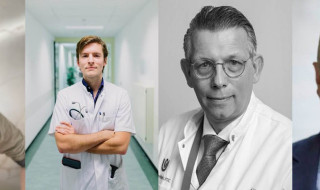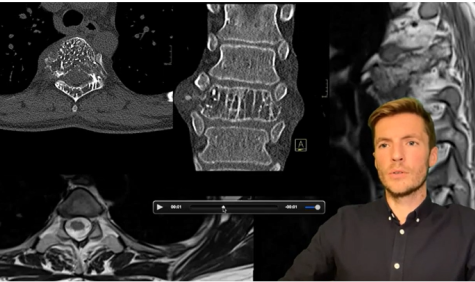"With the Education Clinic, we wanted to create a safe and accessible environment to ask questions just the same"
Students get answers via YouTube to what they never dared to ask
In the master's phase, medical students are no longer taught medical imaging (radiology), nor is there guidance from a radiologist. However, there is a need for education in imaging, as it is an important part of diagnostics. Amsterdam UMC and the UvA have therefore developed the Radiology Education Clinic.
On this teaching clinic platform, co-assistants, undergraduates and other interested parties can ask their questions about imaging. Radiology lecturers answer the questions during a live broadcast via YouTube.
Education for co-assistants: things you always wanted to know but never dared to ask. So it says on the education clinic's YouTube channel. "And that's exactly what it is," says doctor and radiology lecturer Matthias Cabri. "We found out that many co-assistants are unsure about imaging. So during a multidisciplinary meeting or other major healthcare consultation, they prefer to keep quiet, just to avoid asking stupid questions. And because they no longer receive education in this area, there is a risk that their knowledge will lag behind in the rest of their careers. With the Education Clinic, we wanted to create a safe and accessible environment to ask those very questions."

Matthias Cabri, Frank Smithuis, Mario Maas, Jean-Paul Geerets
Next level teaching
The Teaching Outpatient Radiology team consists of four members: the creator of the concept Matthias Cabri, radiologist Mario Maas, skeletal radiologist Frank Smithuis and system administrator Jean-Paul Geerets, all working at Amsterdam UMC. "A safe environment Matthias calls it," says Mario Maas. "It is, for the students. But for óns it was incredibly exciting, especially the first time. What did we get ourselves into, I thought when I first stood there. This way of teaching involves so much more. You are almost presenting a television programme. Of course, you want to go into the content of the questions, but you also have to consider the technology and make sure it comes across as smooth and accessible. And it's live, but you also create a product that stays on for later viewing. This is really next-level teaching."
"This way of teaching involves SO much more. This is really next-level teaching"
Super-vulnerable
Frank and Mario are the presenters/lecturers of Poli Radiologie. Jean-Paul is in charge of technology and Matthias directs and relays questions to Frank and Mario that come in via chat during the live broadcast. "You are super vulnerable as a presenter," says Mario. "You stand around doing your thing and you depend on the people behind the scenes." "Well, I wasn't very relaxed the first time around either, otherwise," says Matthias. "It was a gamble in many areas. The idea is that we take the questions submitted in advance via the website, but there is also live interaction. That should arise from questions coming in via chat during the broadcast. There were exactly zero of those the first time, haha."
Technology plays a crucial role
"We identified what we thought was a big problem and came up with a solution to it," says Frank. "That solution is currently very unusual in the medical and academic world. We had to step out of our comfort zone for it. But apparently we felt it was so important that we were willing to do that. What helps is that we already knew each other well, because you have to have ultimate trust in each other to make such a broadcast. Now we are six videos further on and we are getting better and better acquainted with each other. We are much looser in the room and we no longer rely on a script that is set in stone. In the latest video, we even added a new item where technology plays a crucial role: a live poll."
"We identified what we thought was a big problem and came up with a solution to it"
Physiotherapists and nurses
"Availability was the main requirement. There had to be as few barriers as possible to joining. That's why you don't have to create an account to watch the videos, nor are they behind a pay wall. The videos are primarily intended for co-assistants, but anyone interested is welcome to watch them. We have now also been picked up by physiotherapists and lab technicians. This is only a good thing. Our goal is to increase imaging knowledge, so we welcome all followers and viewers."
700 subscribers and 11,000 views
Speaking of followers: the Education Clinic's YouTube channel now has a good 700 subscribers, its videos have been viewed more than 11,000 times in total, and the number of followers on Instagram is also growing steadily. "It's slow going, but awareness is growing," says Matthias. "Generating audiences through social media was also something we obviously had absolutely no experience with. We knew who we wanted to reach - master's students who have spread to institutions across the country through their co-ops - but we had no idea how."
Flywheel
"I let student councils and student associations know what we were planning. That was also useful because I could immediately ask what questions students had and whether they could send a delegation to sit in the room during the live broadcast. That way, we already had some idea of how to fill the first broadcasts and we immediately had an audience for the much-needed interaction. Other than that, we didn't do much publicity. There wasn't the budget for that either. Fortunately, the flywheel is starting to turn now."
Regular education
Frank: "We are creating reusable education that is accessible to everyone. It should ultimately enrich the available teaching materials that can improve the quality of care in this area. That is what we are all about. The great thing is, our education also improves. Through the construction of submitted questions that we answer during the sessions, we gain more and more insight into where residents are struggling. So we can pay more attention to that in regular teaching."
"It is not easy to find out what your students are really struggling with, also because you encounter them less and less in the traditional classroom situation"
An enrichment
"This is also what I would like to pass on to other institutions," says Mario. "It is not easy to find out what your students are really struggling with, also because you encounter them less and less in the traditional classroom situation. You don't have to do it exactly as we do, but find creative ways and solutions to still reach them and help them develop in the right way. And in doing so, don't be afraid to do something yourself that you have yet to do. See it as an enrichment, for your students, for the programme and for yourself."
Solution to concrete problem
"The Incentive Scheme has ended, but we will find a way to continue the Education Clinic," says Frank. "Master students are happy with it. They come across it with their questions and they go on with their co-supervisions more confidently. It is a successful project and we ourselves are getting more and more pleasure from it. It is still the solution to a very concrete problem. I can imagine that this also applies to other fields, perhaps even outside healthcare. In any case, we will continue with it and anyone can come and see how we do it."
Getting started yourself?
Would you like to get started with the materials developed from this project? Visit the Policlinic Radiology website.
More about the open and online education incentive scheme
This project was created with help from the open and online education incentive scheme. View more results from the scheme's projects.
